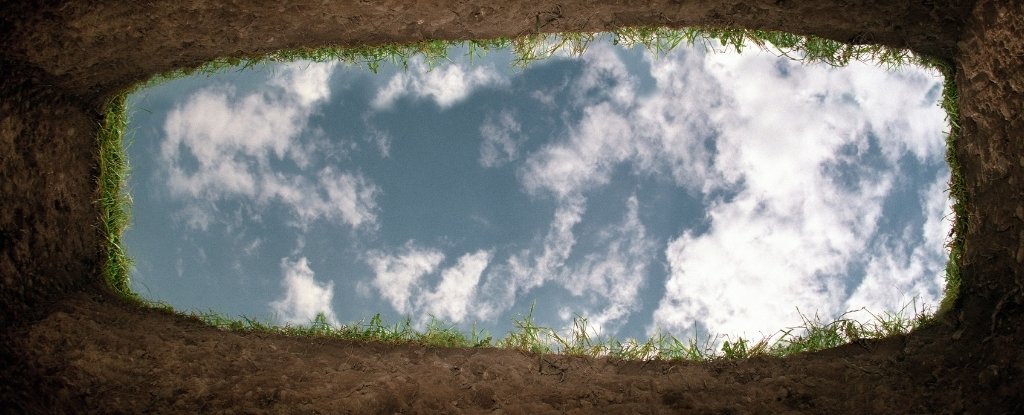Products You May Like
You’d think a plant scientist would feel at home on a farm, but Neil Stewart was used to working with potatoes, not human cadavers.
Fascinated by environmental contaminants, Stewart was on tour at the University of Tennessee’s ‘body farm’ – more formally known as the Anthropology Research Facility – where forensic anthropologists study the effects of human decomposition on a few acres of specially designated land.
It was a little unnerving.
“I tried to distract myself from the bodies and looked up at the forest and some shrubs,” Stewart told ScienceAlert, “then wondered if native plants growing on site might respond to human decomposition and possibly enable detection from the air.”
It was something he’d never considered studying before, but it seemed plausible. When human remains decay on or in the ground, they enter a natural cycle of decomposition that feeds the surrounding soil with microbes and chemicals.
If these nutrients find their way into nearby plant roots, Stewart thinks there’s a chance what’s happening below ground could change the appearance of plants above – perhaps noticeably so.
A year after visiting the farm, Stewart’s joined up with a team of other biologists and anthropologists to find out if these ‘islands of decomposition’ actually exist, and if so, whether that knowledge can be used to find missing persons in the wilderness or hidden human remains.
A newly published editorial in the journal Trends in Plant Science details their ideas for the wider scientific community.
“We propose that forest trees and understory invasive plants may be useful to help pinpoint locations of suspected human decomposition,” the authors write.
“If we can determine the key cadaver-to-soil-to plant signalling parameters, then plants might assist forensic teams in search of missing persons using remote sensing technology.”
Stewart doesn’t really know what they’ll find, but he expects to learn a lot about the interactions between cadavers, their microbiomes, soil microbiomes, and plants.
He thinks the most obvious result will be a large release of nitrogen from decaying islands into the soil, especially in the summer, when human decomposition can happen in a matter of weeks.
“Depending on how quickly the plants respond to the influx of nitrogen, it may cause changes in leaf colour and reflectance,” Stewart suspects.
The editorial estimates that nutrients from a 3-metre square island could seep into the nearby vegetation, providing it with 50 times more seasonal nitrogen fertiliser than usual.
This might lead to a ‘greening effect’, as leaf nitrogen is associated with increased chlorophyll, the green plant pigment required for photosynthesis.
For now, however, the mechanism of these decomposition islands is hypothetical. Scientists haven’t yet investigated whether decayed human remains can cause observable changes in plants, let alone if we can detect them from remote sensors like satellites or unmanned aerial vehicles.
Previous research suggests a corpse can provide 17 out of the 18 elements required for plant growth, but even if plants incorporated these elements, and even if these changes were observable at a distance, more research work needs to be done before we can apply this idea to find a missing person’s body in a densely forested area.
One of the biggest challenges, researchers say, will be separating human decomposition islands from those of other animals, which are often used in cadaver decay research.
In this case, a human diet, which would include synthetic traces of medications and food preservatives, might be a good distinguishing factor.
Plant leaves contain cell walls, made up of lignin, which is strongly fluorescent, and lignin is made from amino acids transported to the plant via its roots. Thus, the team argues, it’s conceivable that amino acids from human remains could be detectable via leaf fluorescence.
“One thought is if we had a specific person who went missing who was, let’s say, a heavy smoker, they could have a chemical profile that could trigger some sort of unique plant response making them easier to locate,” explains Stewart.
Cadmium is a chemical that forms complexes with natural amino acids, and it can be found in high concentrations among those who smoke cigarettes. It’s also readily taken up by plants, and has been shown to affect the cells that contain chlorophyll.
Thus, the plants, which once provided cover for missing bodies, could one day help to reveal them.
Such a reality might still be years away. At this point, Stewart admits the concept is “still far fetched”, but he and a team at the body farm are already setting up the first experiments to test the effect of cadavers on plants.
“We’ve actually built a whole plant imager that can analyse fluorescence signatures,” says Stewart.
“But the first steps are going to be very fine scale, looking at individual leaves and measuring how their reflectance or fluorescence changes over time when plants are near human remains.”
At the moment, the team is trying to learn the speed at which plants respond to human remains and whether different types of trees and shrubs respond in similar ways.
Exotic invasive and weedy plants might be a good place to start, as these have extensive root systems and are generally very responsive to changing environmental conditions, such as water, sunlight, and fertiliser.
Dominant hardwood trees, with their expansive root systems and vast canopies, are also potentially good candidates for further research and aerial surveys.
“While very little molecular biology has been done on the invasive species at the body farm, I’m betting they’ll be quick responders,” Stewart told ScienceAlert.
“It will be interesting if the native trees respond in similar ways – say, a colour change in leaves – but slower. That would be cool.”
The paper was published in Trends in Plant Science.
